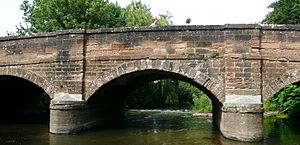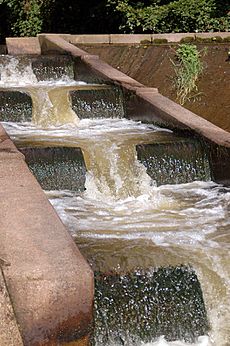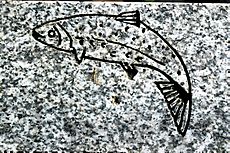River Otter, Devon facts for kids
Quick facts for kids River Otter |
|
|---|---|
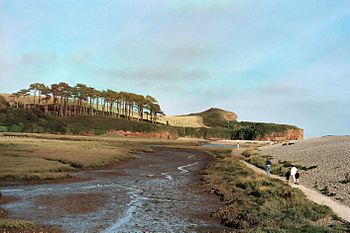
The tidal estuary of the Otter. The river flows left to right, in front of the distinctive hill. The marsh (foreground) is separated from the sea by a steep pebble bar (right).
|
|
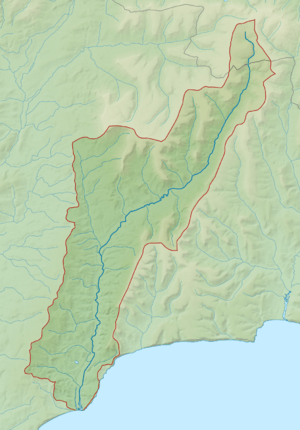
Map of the River Otter and its catchment.
|
|
| Country | England |
| Counties | Somerset, Devon |
| Physical characteristics | |
| Main source | Blackdown Hills, Somerset, England 275 m (902 ft) |
| River mouth | Budleigh Salterton, Devon, England 0 m (0 ft) |
| Length | 44 km (27 mi) |
| Discharge (location 2) |
|
| Basin features | |
| Tributaries |
|
The River Otter is a beautiful river in England. It starts in the Blackdown Hills in Somerset. Then, it flows south through East Devon. Finally, it reaches the English Channel at Lyme Bay. This area is part of the Jurassic Coast, which is a special UNESCO World Heritage Site. The water from the Otter Valley is very important. It provides drinking water for about 200,000 people!
Contents
The River Otter: A Journey Through Devon
Where Does the River Otter Start?
The River Otter begins its journey north of Otterford. A small stream feeds into the Otterhead Lakes. From there, the river flows through Churchstanton before it enters Devon.
The river flows mostly through countryside. You will see small farms with cattle, sheep, and dairy cows. The biggest town in the Otter Valley is Honiton. Many people visit the area for tourism and fun activities.
For most of its path, the river goes through two special areas. These are called Areas of Outstanding Natural Beauty (AONBs). They are the Blackdown Hills AONB and the East Devon AONB.
The river passes by many towns and villages. These include Upottery, Rawridge, Monkton, Honiton, Alfington, Ottery St Mary, Tipton St John, Newton Poppleford, and Otterton. It then reaches the Otter Estuary near Budleigh Salterton.
Wildlife Along the River
The Otter Estuary Nature Reserve is a special place for wildlife. It covers about 57 acres (23 hectares). This area has muddy flats and saltmarshes. Many birds come here, especially in winter.
You can see birds like common redshank, greenshank, and dunlin. Other visitors include common sandpiper and ringed plover. You might also spot Eurasian curlew and common snipe.
Water birds like Eurasian wigeon and Eurasian teal are common. You can also see common shelduck and brent goose. Some birds, like Eurasian reed warbler, build their nests here.
The Environment Agency keeps an eye on the river. They measure the water level at different spots. The place where the river meets the sea is part of the Jurassic Coast. This is a famous World Heritage Site.
A smaller river called the River Tale joins the Otter. This happens northwest of Ottery St Mary. This town is known for the poet Samuel Taylor Coleridge. It also has a fun annual tar barrel rolling event.


In Ottery St Mary, there is a unique circular weir. It is called the Tumbling Weir. Another small stream, Budleigh Brook, also joins the Otter.
Old Mills and New Ideas
Long ago, there were many watermills on the River Otter. There were as many as fifty of them! These mills used the river's power to grind grain or do other work.
One old mill, Tracey Mill near Honiton, still stands. It is thought to be from the 1600s. In the 1970s, fish ponds were built around this mill. Fresh water from the river flows through them every day. This helps to raise trout without needing medicines.
Another mill at Dotton was used from about 1100 to 1960. The building was taken down after that. In 2007, archaeologists from the TV show Time Team dug up the site. This mill was even mentioned in the Domesday Book.
At Otterton, there is another working watermill. It is called Otterton Mill. This mill is over 1,000 years old! It was one of the biggest mills in Devon back in 1086.
Next to the mill, a special "fish pass" was built. It is like a ladder for fish. This helps fish swim upstream past the weir. Now, migratory fish can return to the river after more than 100 years!
The Poet and the River
The famous poet Samuel Taylor Coleridge was born in Ottery St Mary. He lived from 1772 to 1834. He loved the river so much that he wrote a poem about it. It is called "Sonnet to the River Otter".
There is a new bridge in Ottery St Mary named after him. It is called Coleridge Bridge. This bridge is 95 meters long. It is for people to walk and cycle across the river. It opened in 2011.
Beavers Return to the River Otter!
The River Otter is special for another reason. It is the only river in England with wild beavers! Beavers used to live in Britain a long time ago. But they disappeared around 1550.
People first noticed beavers on the River Otter in 2013. The next year, they even had three baby beavers! No one knows exactly how they got there.
At first, some people were worried. Landowners and fishermen were concerned. Farmers worried about diseases. The government even planned to catch the beavers and move them to a zoo. Some fishing groups thought it was too soon to bring beavers back. They wanted rivers to be healthier first.
But many local people and environmental groups protested. They wanted the beavers to stay. Environmental journalist George Monbiot said that most fishermen care about nature. He said seeing wild animals is a big part of fishing.
Environmentalists believe beavers are good for rivers. Their dams create homes for birds and fish. They can also help prevent floods. Beaver dams trap water higher up the river. This can protect homes downstream. Beavers could also become a fun tourist attraction!
In January 2015, a decision was made. The beavers could stay! But first, they had to be checked for diseases. They also had to be the Eurasian type, not the North American type. The beavers passed these checks. They were returned to the river for a five-year trial.
In February 2020, the trial was extended. The government then announced that the beavers could stay forever! There were about 15 beaver families by then. This was the first time an extinct native animal was officially brought back to England. It was a big success!


